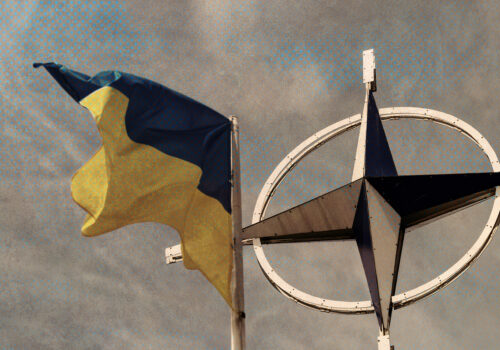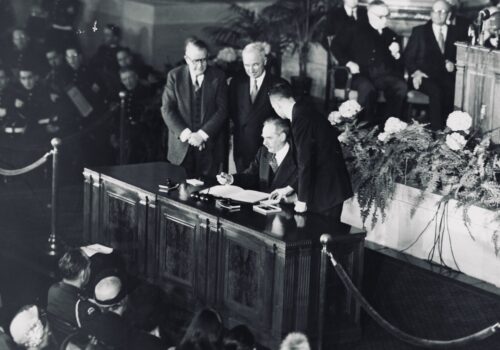Rethinking the NATO burden-sharing debate
“The American well can run dry.” That was US President Dwight D. Eisenhower’s message to European allies in 1953, just four years after NATO was founded. With commitments in East Asia stretching US resources, the time had come for Europe to bear its share of the burden of collective defense.
In other words, the burden-sharing debate is nearly as old as NATO itself. Throughout the 1950s and 1960s, the US contribution to NATO’s total spending on defense was above 70 percent. Since then, most US administrations have urged European countries to do more for their security. In public and in private, US presidents and officials have pressed European governments not to neglect military spending—especially in the post–Cold War period, in which European governments scaled down defense budgets and instead prioritized social programs and tax cuts. In 2011, then US Secretary of Defense Robert Gates sounded the same alarm as Eisenhower, only changing the metaphor from water to wealth. Gates warned that
if current trends in the decline of European defense capabilities are not halted and reversed, future US political leaders—those for whom the Cold War was not the formative experience that it was for me—may not consider the return on America’s investment in NATO worth the cost.
At the same time, over the last decade this ongoing debate about burden-sharing has narrowed, unhelpfully, to focus on a single number. The guideline that NATO allies should each spend at least 2 percent of their gross domestic product (GDP) on defense, established in 2014 with the best of intentions, has since taken on an almost totemic quality as the main criterion of an ally’s worth. The search for a simple benchmark has distorted an important, wider debate in the Alliance. Instead, a fuller understanding of what each ally brings to collective defense is needed, and the upcoming Washington summit is where this process should begin.
Why ‘2 percent’ is reductive
Russia’s first invasion of Ukraine in 2014 began to change calculations. At that year’s NATO Summit in Wales, leaders promised to reach a defense spending target of 2 percent of GDP by 2024. Progress has been made toward that target, but it has been uneven. Russia’s full-scale invasion of Ukraine in 2022 provided yet another impetus for increased spending across European capitals. In German Chancellor Olaf Scholz’s famous Zeitenwende speech, given just days after Russian forces began their all-out assault on Ukraine, he promised that Berlin would finally get serious about meeting the target and allocate an additional one hundred billion euros to a special defense fund.
Last year at the Alliance’s summit in Vilnius, NATO allies renewed their 2 percent pledge and went further, endorsing a Defense Production Action Plan to “accelerate joint procurement, boost interoperability, and generate investment and production capacity.” In 2023, defense spending across European NATO members increased by 19 percent, with around $78 billion dollars of new defense spending, according to data from the Stockholm International Peace Research Institute (SIPRI). This week, NATO announced that twenty-three of the Alliance’s thirty-two member states are expected to meet the 2 percent target in 2024. This year will also be the first in which European allies’ aggregate spending will surpass 2 percent of their collective GDP.
While Europe is clearly headed in the right direction, the United States remains by far the largest single contributor. According to SIPRI’s database, total US defense spending reached $916 billion in 2023, or 3.36 percent of US GDP. In Europe, the three biggest defense spenders were the United Kingdom ($75 billion), Germany ($68 billion), and France ($61 billion) in 2023. Contrast this with China, which between 2000 and 2023 increased its military spending more than thirteen-fold (from $22 billion to $296 billion) and significantly upgraded its military capabilities. Russia has also increased its defense budget by twelve times (from $9 to $109 billion). Moreover, these estimates, based in part on educated guesswork, may undercount China’s and Russia’s actual defense and security spending.
The danger here is that focusing the burden-sharing debate around a mathematical equation is reductive. It fixes attention on inputs and not requirements. It does not translate into a full understanding of what the real military capabilities of allies are or how they are able to employ those capabilities to benefit NATO and enforce the international order.
What’s more, the 2 percent target is itself an inadequate metric. It is a goalpost that shifts depending on wider national economic fortunes. And it’s ill-defined. Allies have broad discretion to determine what is in the scope of the 2 percent target and to indulge in some creative accounting. For instance, generous pension payouts can inflate a country’s defense budget without contributing much to collective capabilities. Not all 2 percent commitments are the same. The 2014 NATO Summit that set the 2 percent target also included the target that by 2024, a minimum of 20 percent of national defense spending would go toward frontline capabilities, equipment, and research and development. All but two allies are above this mark, according to the most recent data, but these figures fluctuate each year.
How allies can move beyond ‘2 percent’
It is in the interest of individual European allies to demonstrate the tangible ways in which they are contributing to collective defense and deterrence. This includes strengthening conventional forces, including through contributions to multinational deployments on NATO’s eastern flank. It includes showing a proactive readiness to fill the gaps in strategic enablers that the United States currently supplies for Europe’s defense. This means building out airlift capabilities, air-to-air refueling, and intelligence, surveillance, and reconnaissance aircraft and platforms. It also means allies need a coherent plan to make smarter use of existing resources across Europe and to develop a strategy for partnering with defense manufacturers to ensure the continuity of critical supplies.
Perhaps most critically now, allies need to get the messaging right. This could start by ditching the notion of collective defense as a “burden” and adopt the language of “responsibility sharing” instead. Reframing the debate would help signal to the public a calm, mature, and committed resolve.
With the NATO Summit taking place in Washington, DC, in July, during a US presidential election campaign, European allies cannot ignore the political context. At the NATO Summit and beyond, they will need to carefully calibrate their messaging to the US public in a way that appeals to both sides of the political aisle. That means, for instance, giving concrete signals that European allies can be relied on as valuable and constructive partners globally, particularly in the Indo-Pacific.
Ultimately, considerations of messaging and politics bring the discussion back to the 2 percent target. It has assumed a particular symbolic potency. As NATO history demonstrates, this debate will remain in one form or another for a long time. Indeed, 2 percent is now spoken of as a “floor and not a ceiling,” with some allies, most vocally Poland, which advocates raising the target to 3 percent. Republican US Senator Roger Wicker recently argued that the United States should be spending as much as 5 percent of its GDP on defense.
As more and more allies cross the 2 percent threshold, and as spending accelerates, it’s time for the conversation to evolve. To consider not just how much is spent, but how it’s spent. To examine how that translates to each ally meaningfully and tangibly taking responsibility for collective defense. That’s a more nuanced message than a simple equation, but the time to start telling that story is now.
Valbona Zeneli is a nonresident senior fellow at the Atlantic Council’s Europe Center and at the Transatlantic Security Initiative of the Atlantic Council’s Scowcroft Center for Strategy and Security.
Philippe Dickinson is the deputy director of the Transatlantic Security Initiative and a former career diplomat for the United Kingdom.
NATO’s seventy-fifth anniversary is a milestone in a remarkable story of reinvention, adaptation, and unity. However, as the Alliance seeks to secure its future for the next seventy-five years, it faces the revanchism of old rivals, escalating strategic competition, and uncertainties over the future of the rules-based international order.
With partners and allies turning attention from celebrations to challenges, the Atlantic Council’s Transatlantic Security Initiative invited contributors to engage with the most pressing concerns ahead of the historic Washington summit and chart a path for the Alliance’s future. This series will feature seven essays focused on concrete issues that NATO must address at the Washington summit and five essays that examine longer-term challenges the Alliance must confront to ensure transatlantic security.
Further reading
Mon, Jun 10, 2024
Building the bridge: How to inject credibility into NATO’s promise of membership for Ukraine
New Atlanticist By Ian Brzezinski
Ukraine’s bridge to NATO membership must be built in ways that institutionalize its integration into the Alliance’s structures—starting now.
Mon, Jun 3, 2024
National resilience is a crucial part of defense. Here are the countries doing it right.
New Atlanticist By Elisabeth Braw
Learning from the allies that are already taking action will give other NATO members that decide to enhance their resilience a leg up.
Thu, Apr 4, 2024
NATO at 75: ‘The most powerful and successful alliance in history’
New Atlanticist By Christopher Skaluba, Philippe Dickinson, Dominykas Kaminskas
Maintaining NATO’s effectiveness requires recommitting to the Alliance’s transatlantic vision today, tomorrow, and into the years ahead.
Image: Soldiers of the NATO Response Force (NRF) stand next to military vehicles as they attend a Norwegian, Czech, and German combat exercise during a press day as part of the "Quadriga 2024" training in Gardelegen, Germany, April 8, 2024. REUTERS/Liesa Johannssen


